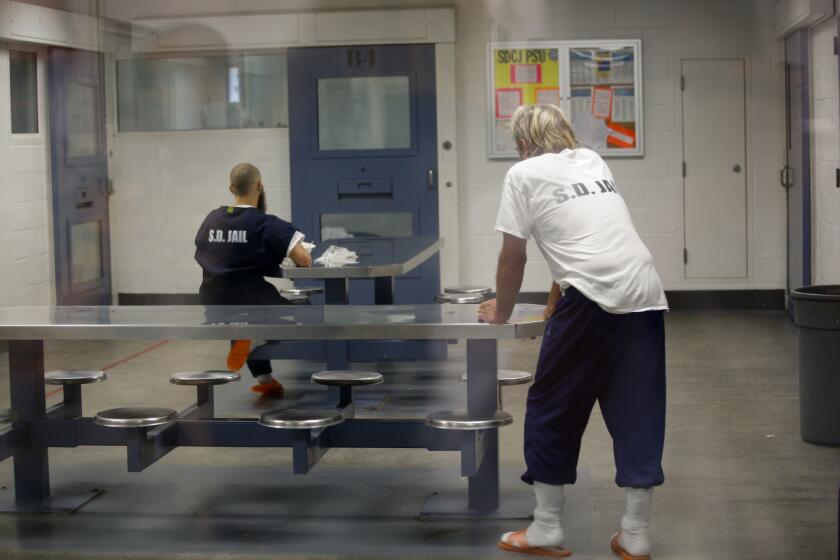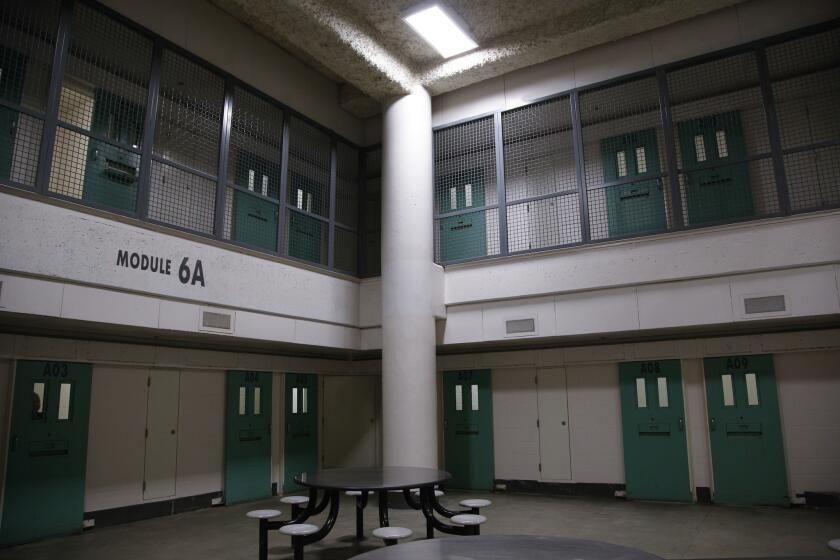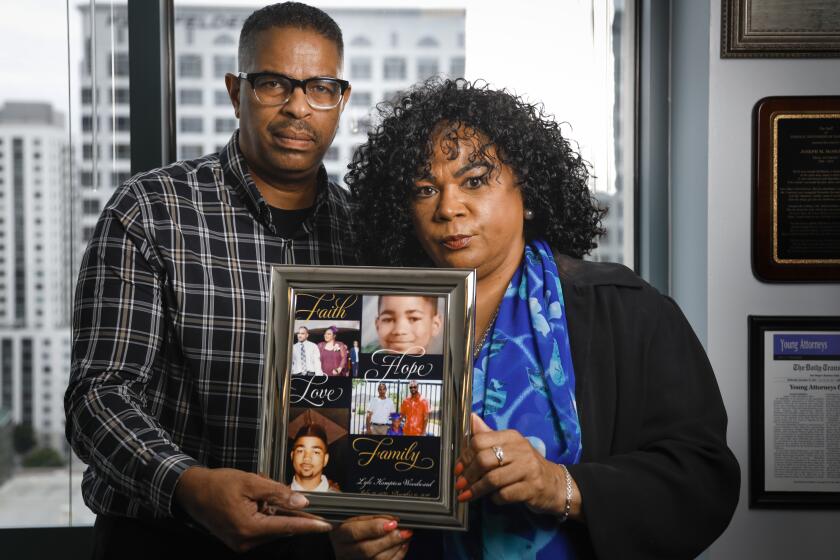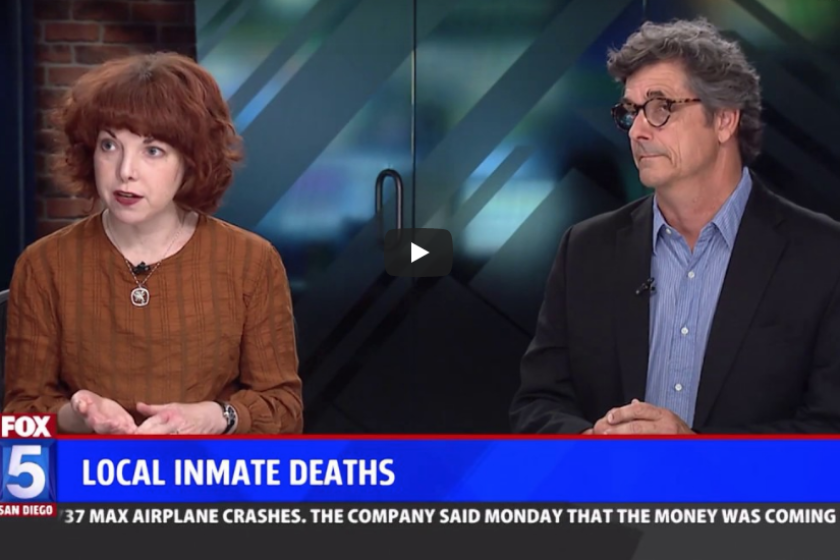Jail’s leading mortality rate is costing county millions of dollars in lawsuit payouts
At least 140 people have died in San Diego County jails since 2009, the year Bill Gore took over as sheriff. That’s an average higher than one inmate per month, every month, over the past 10 years.
Some are claimed by natural causes — chronic health conditions like heart disease and diabetes often found in people who end up in jail. Others are murdered or overdose on drugs.
Dozens have taken their own lives even though Gore and his top command staff say they do everything they can to identify suicidal inmates and treat mental illness.
“The Sheriff’s Department is committed to keeping inmates safe and is continuously looking for best practices in the delivery of mental health care,” the department said in a video posted on its website in May.
A six-month investigation by The San Diego Union-Tribune shows that the county’s jail mortality rate is the highest among California’s largest county jail systems. The grim history shows no sign of waning.
Kelly Davis, Jeff McDonald break down the story on San Diego News Fix
Fifteen inmates died in county custody in each of the past two years, out of a population of more than 5,000. Twelve inmates have died so far this year.
There is no easy explanation.
Over the past several years, the department has improved training, changed health care providers and brought in new equipment. But it has been slow to make more obvious fixes, like installing fencing to prevent suicidal inmates from jumping, or bolstering its mental health staff to provide around-the-clock care.
Despite years of controversy over departmental lapses and repeated promises of reform, deaths this year include:
- A young man who repeatedly threatened to commit suicide and had access to a plastic bag to suffocate himself after being found earlier in the day with a noose in his cell.
- A 34-year-old with a serious heart condition who was given cough syrup instead of his prescription medication when he told staff he was having trouble breathing.
- A young veteran who struggled with opiate and methamphetamine addiction after his hand was blown off in Afghanistan. He died with withdrawal symptoms less than an hour after being returned to his cell from the infirmary.
As recently as Friday, the Sheriff’s Department acknowledged in response to a records request that 29-year-old Daniel James Pickett of Cashmere, Washington, died Sept. 6 in custody on drug possession charges. The cause was not made public.
The deaths overwhelmingly occurred among those like Pickett who were booked but not convicted, Sheriff’s Department data show.Since 2009, 115 of the 140 inmates who died behind bars were awaiting trial.
The loss of life causes more than anguish for friends and relatives of those who perish. The deaths cost taxpayers millions of dollars in legal settlements and attorney fees.
Over the past decade, the county paid at least $7.9 million to families of people who died or were badly injured in jail. That’s more than four times the $1.9 million cost of similar legal actions in the prior decade, before Gore took over as sheriff.
The total does not include a $12 million jury verdict awarded in July to a North County man who suffered brain damage from a fall after being arrested and booked into jail.
San Diego County is defending itself in at least a dozen other state and federal lawsuits brought by inmates and family members. Some recent deaths also are likely headed to court.
The continuing deaths and lawsuits are reflective of the county’s indifference, critics say.
“A measure of society is how we treat our most vulnerable. By that measure, San Diego County is failing miserably,” said Julia Yoo, a San Diego attorney who has sued the sheriff repeatedly on behalf of deceased inmates’ families.

Deaths, suicides on the rise
According to Sheriff’s Department reports, 140 people have died in the county’s seven detention facilities since 2009, the year Gore was promoted from undersheriff by the Board of Supervisors after the mid-term resignation of William Kolender.
One inmate killed himself July 3, 2009 — Gore’s first official day in charge.
In the 10 calendar years before Gore’s appointment, 101 inmates died in county custody, department records show.
The rise in jail suicides was even more pronounced. In the decade between 1999 and 2008, 23 inmates killed themselves, the Sheriff’s Department said. The number of suicides between 2009 and 2018 increased to 39, a 70 percent increase.
“We don’t want any suicides in our facilities. We want to be able to stop all of them.”
— Capt. Alan Kneeshaw
Multiple inmates killed themselves after sheriff’s deputies were warned they were suicidal and needed frequent monitoring.
Several died after jumping from upper floors in the county’s three largest jails. The department has not installed protective fencing on all the upper floors of its detention centers, although officials said they modified some railings.
An active-duty sailor wanted for a crime in Colorado threatened to jump off the San Diego-Coronado Bridge in 2016. He was successfully talked off the ledge and ended up in the George Bailey Detention Facility in Otay Mesa pending extradition. He jumped headfirst off a second-story ledge to his death.
The incident came three years after the county paid $80,000 to settle a lawsuit filed by the parents of Robert Lubsen, 26, who was jailed after stealing laptops from Cal State San Marcos.
Despite bearing bright red ligature marks from an earlier suicide attempt in his booking photo, Lubsen was not flagged as a suicide risk and managed to leap to his death as well.
As part of the legal settlement, Lubsen’s family insisted on meeting with Gore to prevent others from suffering the same fate.
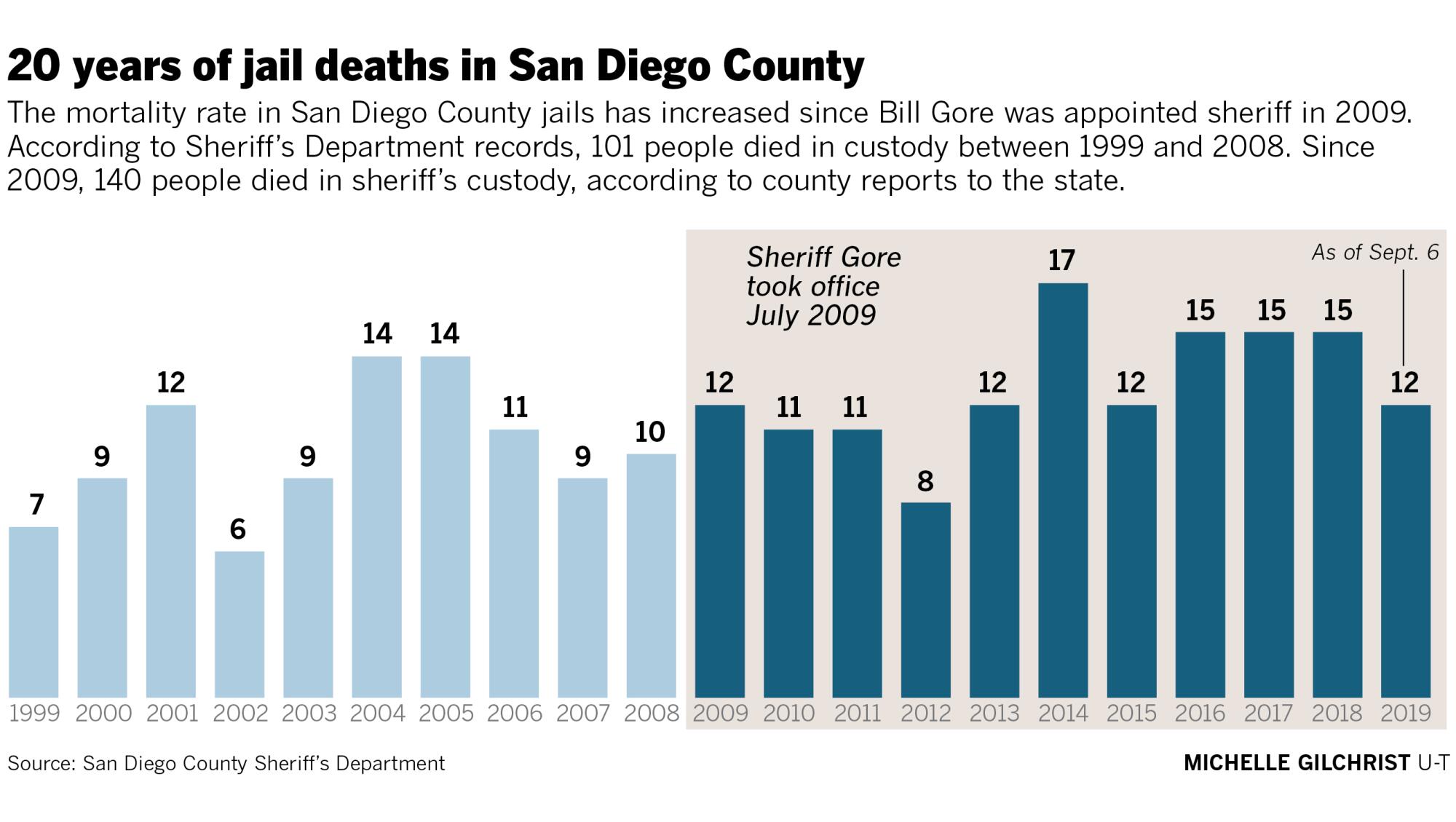
‘An abundance of notice’
San Diego County’s overall mortality rate over the past decade is the highest among California’s six largest jail systems, according to data those departments are required to report to the state Department of Justice.
The county recorded an average of 12.8 deaths per year, for an annual mortality rate of 246 per 100,000 inmates.
By comparison, Los Angeles County, whose jail system is three times larger than San Diego County’s, had an inmate mortality rate of 158. San Bernardino County’s was 149 and Sacramento County’s was 94.
The most prominent reported reason for jail deaths is natural causes.
Of the 140 deaths in San Diego County jails since 2009, nearly half were attributed to natural causes. Autopsy reports suggest some of those deaths might have been prevented if inmates had received better medical care. Reports show multiple inmates dying from treatable conditions like diabetes, pneumonia and stomach ulcers.
The second most common cause of death was suicide. San Diego County’s jail suicide rate is higher than the other five large counties, at 75 per 100,000 over 10 years.
In Los Angeles County, the rate was 26 per 100,000. The rates in San Bernardino and Sacramento counties were 44 and 23 respectively, and Orange County reported the lowest at 15.
The Sheriff’s Department argues that the demographics of local jail populations account for the differences in suicide rates across the state. Either way, the stories of jail suicide are harrowing examples of an undeniable mental health crisis within the criminal justice system.
Among the 40 men and women who took their lives in San Diego County jails over the past decade, many suffered from mental illness, according to autopsy reports.
Kristopher Nesmith’s wife warned sheriff’s deputies before he was sent to the Vista Detention Facility in 2013 that her husband had tried to kill himself. The former Marine with a history of mental illness hung himself behind bars in early 2014.
“VDF staff in this case had an abundance of notice that Kris was suicidal and posed an immediate danger to himself,” U.S. District Court Judge Janis Sammartino wrote in a March ruling denying San Diego County’s request to dismiss the wrongful-death lawsuit.
At least 17 inmates have died from drug overdoses since 2009. Seven were able to obtain a lethal amount of drugs in jail, autopsy records show. The others ingested drugs before their arrest.
Gore has said publicly that stopping the smuggling of drugs into jails presents a continuing challenge.
“You can’t imagine the ingenuity of inmates,” the sheriff told the Citizens’ Law Enforcement Review Board at an April meeting of the oversight panel.
Five years ago, Gore spent more than $1.5 million in asset-forfeiture funds on a jail X-ray system designed to find drugs hidden or ingested by inmates before booking. While it has helped, it has limitations, jail officials said.
This past February, Joseph Castiglione swallowed a large amount of methamphetamine wrapped in plastic, investigators said. The 56-year-old man died after being shackled and placed face down on a gurney by deputies at the Vista jail.
Three months later, a grand jury report chided the Sheriff’s Department for failing to upgrade the X-ray system’s software.
Inmate named ‘Evil’
A smaller but growing number of inmates in San Diego jails have become homicide victims. The Sheriff’s Department reported 10 in-custody homicides since 2009, a five-fold increase over the prior decade.
Most of the victims were attacked by other inmates.
In one case, a 70-year-old mentally ill prisoner was beaten to death by a larger inmate nicknamed “Evil” who rallied four other inmates to join in the attack. A deputy had complied with the victim’s request to be moved from protective custody into the jail’s general population, despite orders to keep him segregated for his own safety.
In another case, the Medical Examiner’s Office earlier this year released a previously sealed report on the 2018 death of Oscar Leal. The autopsy ruled Leal’s death a homicide, caused by a heart attack triggered by his drug use and the way deputies restrained him. He was 37.
“There were minor blunt force injuries of the head, torso and extremities,” the autopsy said, “as well as abrasions, bleeding under the skin and lacerations on both wrists consistent with handcuffs.”
A video from the jail’s sallyport shows deputies fumbling with leg restraints before noticing that Leal had stopped breathing.
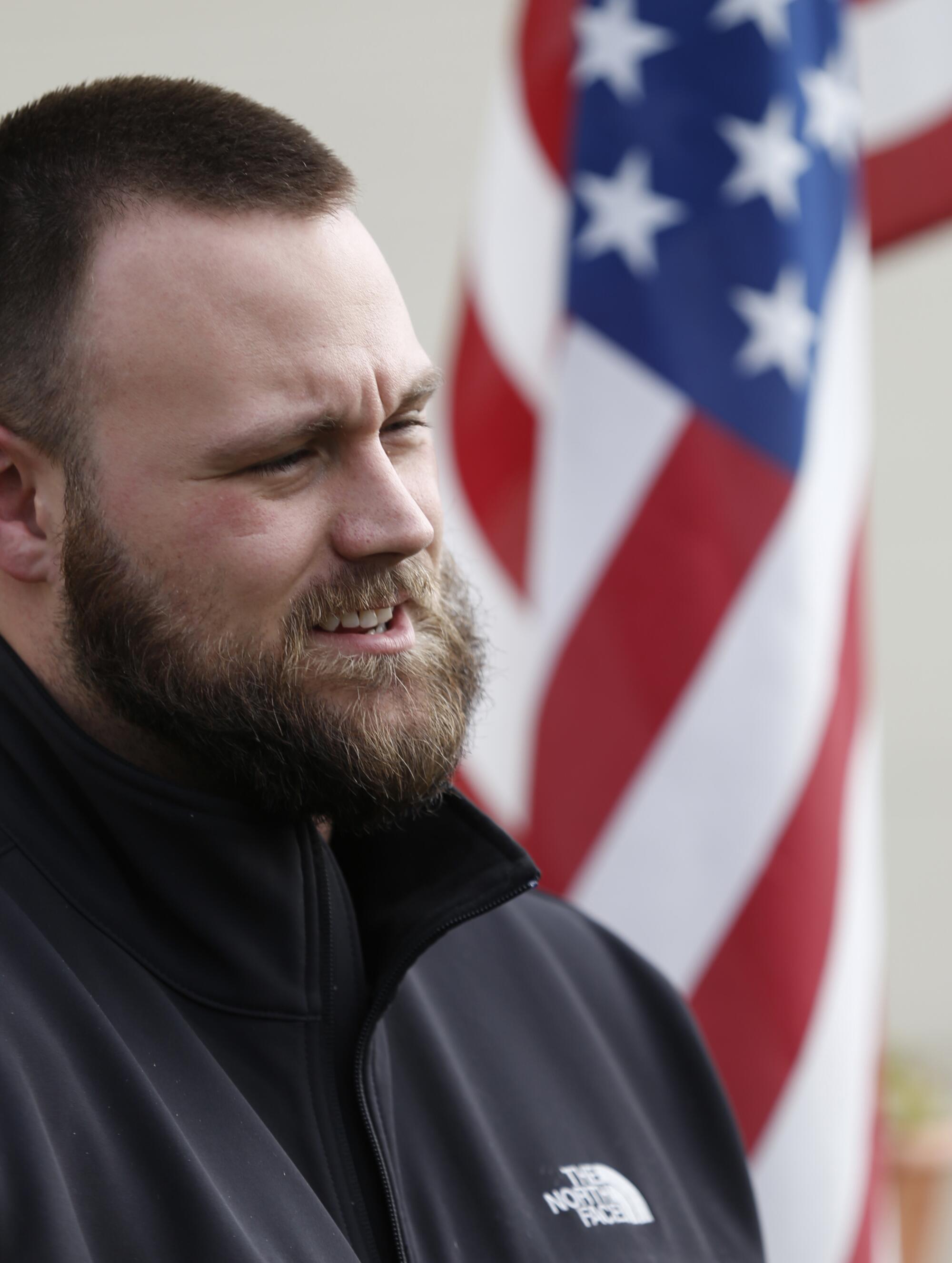
Gore took the unusual step of issuing a statement publicly rejecting the medical examiner’s finding and blaming the death on Leal.
“Were it not for Mr. Leal’s abuse of methamphetamine, he would be alive today,” the sheriff said in a written statement.
Jeremy Thomas, a 28-year-old former Marine who died May 29 in the Central Jail, had been booked on drug charges.
Thomas lost his hand in Afghanistan in 2011 and was featured in a Union-Tribune story two years ago about veterans being over-prescribed opioids for pain.
J.R. Wilkinson, an attorney retained by the Thomas family, said the young man told medical staff that he was going through withdrawal.
“Rather than treating him for withdrawal and monitoring him, he was sent to his cell. Shortly after, he was pronounced dead,” Wilkinson said. “As a wounded vet and father, Jeremy deserved better. The San Diego Sheriff’s Department needs to be held accountable for his wrongful death.”

Attempted fixes
Over the years, the Sheriff’s Department introduced tools and procedural changes aimed at reducing jail deaths.
In early 2015, for example, following 11 suicides in less than two years, the department developed a suicide-prevention program.
Officials strengthened intake screening so booking staff would ask more pointed questions of arresting officers and of inmates. The idea was to ensure detainees were housed in appropriate settings and steered into treatment.
The department also launched a video-based “telepsychiatry” program, so inmates could speak to a doctor more often. That program ended due to data-security concerns.
The jail also created “enhanced observation housing,” so deputies could better monitor inmates who express an intent to harm themselves. Inmates in these units are given tear-proof smocks and blankets and sleep on mats or bunks that have been modified to reduce the chance of hanging.
Success has been elusive.
By the end of 2015, six more inmates had killed themselves. In 2016, five inmates committed suicide, and at least half a dozen have taken their lives since 2017.
Ivan Ortiz managed to suffocate himself on March 18 while housed in the jail’s psychiatric observation unit, its highest level of care for mentally ill inmates.
According to his autopsy report, Ortiz tried unsuccessfully to hang himself that morning and told jail staff he “felt like ending his life.” That afternoon, according to surveillance video, he climbed under a sheet and put a plastic bag over his head and died. Nearly an hour passed before deputies checked on him. Ortiz’s family has retained an attorney.
While sheriff’s officials were telling plaintiffs’ lawyers — and the public — that department practices were sound, internally there was concern that the number of suicides was too high, according to internal documents released as part of ongoing litigation.
“Is it a problem?” a department PowerPoint slide about jail suicides asked. “YES ... a definite problem.”
The undated presentation listed the main challenges: a lack of funding for mental health professionals, lack of training and knowledge for staff and contractors, undetected and under-reported cases of troubled inmates and 9-to-5 clinical hours for mental health providers.
Sheriff’s officials subsequently expanded mental health clinicians’ hours to be available from 6 a.m. to 10:30 p.m. They hope to have 24-hour coverage at most facilities once 15 new budgeted positions are filled and staff is increased to 27.
“Suicide prevention is very important to all of us. Even if we lose one person, it’s one too many. … The sheriff has made it a priority for us to not only expand our mental health services, but to enhance our suicide prevention training.”
— Cmdr. Erica Frierson, Sheriff’s Department
“In 2010, we only had four mental-health clinicians, so for us it’s a big change,” Cmdr. Erika Frierson, who manages jail operations including medical services and inmate processing, said in an interview.
The frequency of inmate suicides in San Diego County has drawn criticism from experts and lay people.
Last year, the nonprofit advocacy group Disability Rights California concluded in a report that the jail system was in crisis, recording suicides at a rate that was five times that of the state prison system, which, the report notes, has been under court supervision for its own problem with suicides.
“There is an extensive public record documenting the tragic loss of lives, systemic failures and inadequacy of oversight,” the report says. “Families of those who have died have filed lawsuits alleging that the county and jail staff acted with deliberate indifference to inmates’ serious mental health, medical and related needs.”
The report singled out the department’s “enhanced observation housing” program and the jails’ padded safety cells, saying they isolate inmates indefinitely and fail to provide meaningful mental health care.
“We reviewed multiple records documenting that EOH inmates were left naked, with no safety smock, and in some cases not even provided a blanket,” the researchers wrote. “Some are forced to sleep on a thin mat placed on the floor.”
The report urged the department to allow inmates under enhanced observation to have visitors, participate in recreational activities and be allowed to wear clothing and keep personal items in their cells if a mental health clinician deemed it safe.
“The money you need to reform the system is being spent paying out lawsuits for people who are dying. You know, $7 million here, $1 million there, that adds up pretty quickly.”
— John Snook, Treatment Advocacy Center
Lindsay Hayes, a consultant hired last year to assess the department’s suicide prevention protocol, echoed these recommendations. His report describes enhanced observation cells as “quite dirty and unsanitary, with feces found on the walls in close proximity to the CCTV monitor.”
In response to Hayes’ finding, the department said each cell would get a daily cleaning.
Disability Rights California issued dozens of recommendations, including improving mental-health treatment, boosting staff and ending the use of solitary confinement where, according to jail policies, inmates spend 47 hours in a cell before getting an hour of yard time.
The Sheriff’s Department argues that the nature of jail populations makes certain comparisons misleading, but nonetheless has implemented some of the recommendations, such as changing policies to reduce use of isolated and austere “safety” cells and adding an internal team to review suicide responses.
A sheriff’s spokeswoman also said a dip in suicides — to one — in 2017 was partially due to improved deputy training and increased access to inmate services.
Others called on the sheriff to establish meaningful independent oversight of jail conditions.
Two years ago, volunteer members of the county grand jury reviewed San Diego County jail operations and said the Sheriff’s Department’s suicide-prevention plan lacked provisions for adequate training. Jurors also urged the sheriff to appoint a full-time mental health officer.
“The recommendation will not be implemented because it is not warranted,” the department said in response.
‘No, don’t do it’
It’s unclear if having a mental health officer might have helped Paul Silva, a 39-year-old diagnosed schizophrenic who did not survive his experience in sheriff’s custody.
Silva’s mother, Leslie Allen, called police to her San Diego home on Feb. 20, 2018, because her son was outside her home, yelling and agitated. She told the dispatcher her son was mentally ill and likely had not taken his medication. Allen wanted Silva transported to a mental health facility for treatment.
Instead, he was booked into the Central Jail on suspicion of being under the influence of illegal drugs. He received no treatment, the family’s federal lawsuit states, and was kept in a temporary holding cell for 29 hours “with no shower, no toilet paper, no soap, no clean clothes, and no bed.”
Footage from a hallway camera trained on the cell’s window showed Silva pacing back and forth and “appearing to speak to the wall.”
When a deputy found Silva yelling incoherently, he summoned help, the lawsuit said.
“Paul was Tased between four to nine times while six other members of the Tactical Team held him down with a body shield and pressed down on his torso,” the lawsuit said. “At least six members were on or around his body with a shield placed on top of his torso, with two officers pushing down on the shield.
“One deputy instructed the other members to use ‘downward pressure with the shield, get your body weight on it.’ These deputies heard Paul yell ‘No, don’t do it, sir.’ Paul’s voice then became faint and unintelligible,” the lawsuit said.
“No matter what the situation is, jail is likely to make things worse. If the person hasn’t been receiving adequate treatment services, putting them in a harsh and dangerous setting like jail or solitary confinement is likely going to make them worse and certainly isn’t going do much to make them better.”
— Aaron Fischer, Disability Rights California
Silva was transported to UC San Diego Medical Center, where he fell into a coma and died March 28, about five weeks after he was jailed.
The Medical Examiner’s Office ruled the manner of death a homicide. Toxicology tests for alcohol, methamphetamine, opiates, barbiturates and cocaine were negative.
Attorney Eugene Iredale, who sued in U.S. District Court on behalf of the Silva family, said San Diego County elected leaders have a history of short-term thinking when it comes to providing inmate health care.
“The county has been trying to do things on the cheap,” said Iredale, who has successfully sued the Sheriff’s Department for other inmate deaths. “Instead of hiring good doctors at a good salary with institutional memories, they contract it out.
“If you look at the settlements and legal costs, they’re not getting a bargain,” he said. “They’re buying the liability that comes with substandard care.”
The District Attorney’s Office last year cleared sheriff’s deputies of negligence and misconduct in Paul Silva’s death.
The county’s motion to dismiss a lawsuit filed by Silva’s parents was denied and the case is pending.
Despite initially rejecting the grand jury’s recommendation, the Sheriff’s Department recently said it has changed course and will appoint a new mental health leader.
“We recognized our growth has now created the need for both a chief medical officer to oversee our medical services as well as a mental health director to oversee mental health services,” the department said in a statement. “Together they will be responsible for ensuring both disciplines provide collaborative, efficient and effective patient care.”
Dr. Jon Montgomery recently took over as chief medical officer, the department said. The mental health director position has been funded and candidates are being interviewed.
Next installments
Monday: Lapses in treatment, medical care spell horrific ends for mentally ill inmates
Tuesday: Jail deaths are routinely investigated, but public findings are hard to come by
Updates
11:44 a.m. Sept. 20, 2019: This story was updated to add news of the death of Daniel James Pickett.
Get Essential San Diego, weekday mornings
Get top headlines from the Union-Tribune in your inbox weekday mornings, including top news, local, sports, business, entertainment and opinion.
You may occasionally receive promotional content from the San Diego Union-Tribune.


